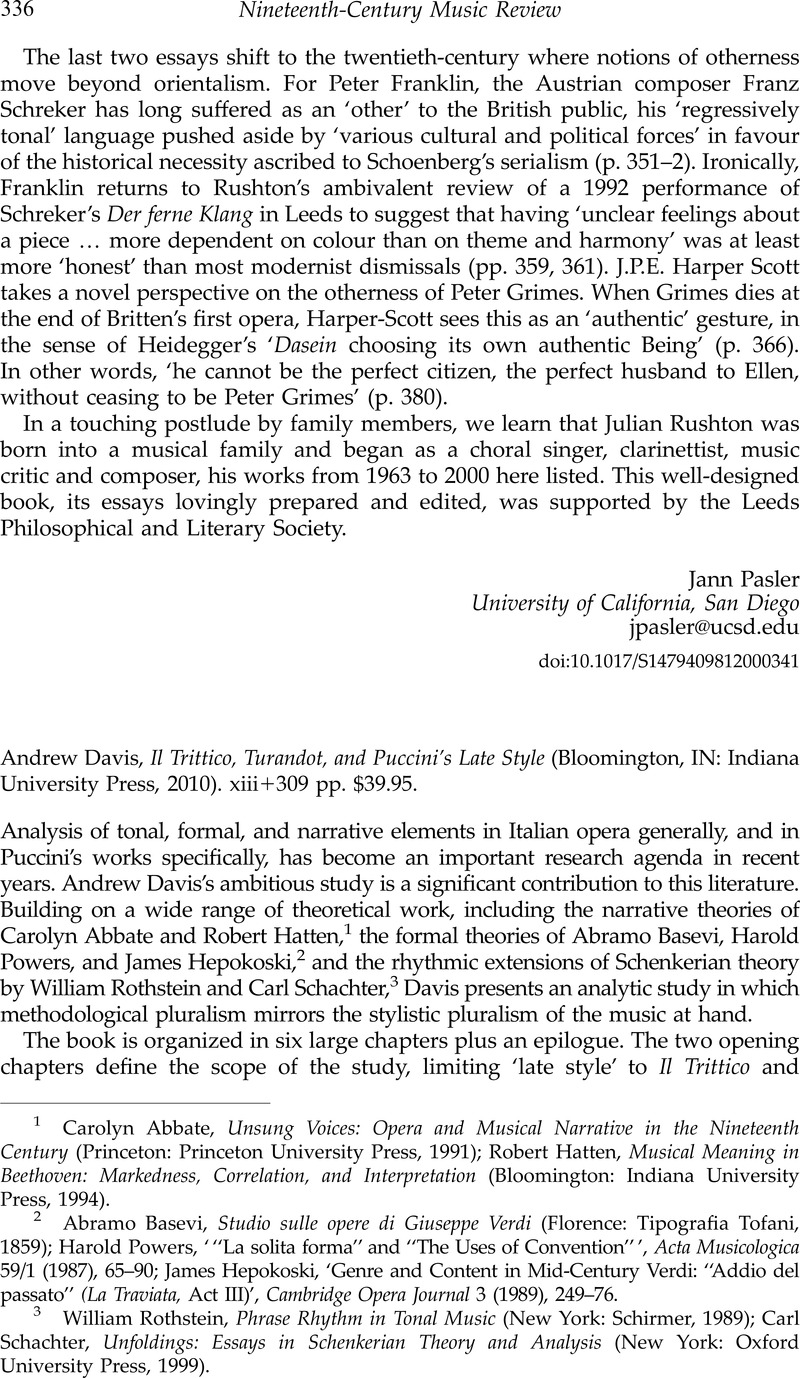No CrossRef data available.
Published online by Cambridge University Press: 08 January 2013

1 Abbate, Carolyn, Unsung Voices: Opera and Musical Narrative in the Nineteenth Century (Princeton: Princeton University Press, 1991)CrossRefGoogle Scholar
Hatten, Robert, Musical Meaning in Beethoven: Markedness, Correlation, and Interpretation (Bloomington: Indiana University Press, 1994)Google Scholar
2 Basevi, Abramo, Studio sulle opere di Giuseppe Verdi (Florence: Tipografia Tofani, 1859)Google Scholar
Powers, Harold, ‘ “La solita forma” and “The Uses of Convention” ’, Acta Musicologica 59/1 (1987), 65–90Google Scholar
Hepokoski, James, ‘Genre and Content in Mid-Century Verdi: “Addio del passato” (La Traviata, Act III)’, Cambridge Opera Journal 3 (1989), 249–76Google Scholar
3 Rothstein, William, Phrase Rhythm in Tonal Music (New York: Schirmer, 1989)Google Scholar
Schachter, Carl, Unfoldings: Essays in Schenkerian Theory and Analysis (New York: Oxford University Press, 1999)Google Scholar
4 Davis draws on a considerable range of analytic and historical research beyond the sources listed here: his bibliography contains 422 items.
5 Lenormond, René, Étude sur l'harmonie Moderne (Paris: Le monde musical, 1913)Google Scholar
6 Davis's main sources for the theory of markedness are Abbate (1991) and Hatten (1994).
7 Locke, Ralph, Musical Exoticism: Images and Reflections (Cambridge: Cambridge University Press, 2009)Google Scholar
8 Basevi (1859), p. 191. The four parts, or movements, of ‘la solita forma d'duetti’ are enumerated by Basevi as tempo d'attacco, adagio, tempo di mezzo, and cabaletta. The terminology has become standard in musicological literature on form in nineteenth-century opera.
9 Hepokoski, James, ‘Beethoven Reception: The Symphonic Tradition’, in The Cambridge History of Nineteenth-Century Music, ed. Jim Samson (Cambridge, Cambridge University Press, 2002), 424–459Google Scholar
10 Alfred Lorenz, Das Geheimnis der Form bei Richard Wagner, 4 vols. (Berlin: Max Hesses Verlag, 1924–1933)Google Scholar
Bailey, Robert, ‘The Structure of The Ring And its Evolution’, Nineteenth-Century Music 1 (1977), 48–61Google Scholar
McCreless, Patrick, Wagner's Siegfried: Its Drama, History, and Music (Ann Arbor: UMI Research Press, 1982)Google Scholar
Darcy, Warren, Wagner's Das Rheingold (Oxford: Clarendon Press, 1993)Google Scholar
11 Robert Moreen, Integration of Text Forms and Musical Forms In Verdi's Early Operas (Ph.D. Thesis, Princeton University, 1975)Google Scholar
12 Gossett, Philip, ‘Verdi, Ghislanzoni, and Aida: The Uses of Convention’, Critical Inquiry 1/2 (1974), 291–334Google Scholar
James Hepokoski, Giuseppe Verdi: Otello (Cambridge: Cambridge University Press, 1987)Google Scholar
Rosen, David, ‘ “La solita forma” in Puccini's Operas?’, Studi Pucciniani 3 (2004), 179–99Google Scholar
13 Roger Parker, ‘ “Insolite Forme”, or Basevi's “Garden Path” ’, in Roger Parker, Remaking the Song: Operatic Visions and Revisions from Handel to Berio (Berkeley: University of California Press, 2006)Google Scholar
14 Ashbrook, William and Powers, Harold, Puccini's Turandot: The End of the Grand Tradition (Princeton: Princeton University Press, 1991)CrossRefGoogle Scholar
15 Definition of keys within the individual styles identified by Davis represent another important avenue for further study. A much more rigorous distinction between chord roots, key areas, composed-out Stufen, etc. would strengthen the analyses throughout the book.
16 On p. 151, the key signature (two flats) is missing; on p. 154–5, all clefs and key signatures are missing.